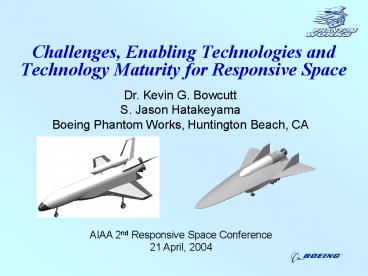Challenges, Enabling Technologies and Technology Maturity for Responsive Space - PowerPoint PPT Presentation
1 / 16
Title:
Challenges, Enabling Technologies and Technology Maturity for Responsive Space
Description:
... -Breathing RLV Example of Proposed Technology Maturation Process Four technologies deemed critical and enabling for a hypersonic air-breathing RLV ... – PowerPoint PPT presentation
Number of Views:457
Avg rating:3.0/5.0
Title: Challenges, Enabling Technologies and Technology Maturity for Responsive Space
1
Challenges, Enabling Technologies and Technology
Maturity for Responsive Space
Dr. Kevin G. Bowcutt S. Jason Hatakeyama Boeing
Phantom Works, Huntington Beach, CA
AIAA 2nd Responsive Space Conference 21 April,
2004
2
Introduction
- Over the past 20 years there have been numerous
attempts to develop a new RLV - All failed or prematurely canceled
- All share a common issue lack of technology
maturity of fundamental components to meet needs
of RLV safety, reliability, affordability and
responsiveness - Focusing only on the truly enabling RLV
technologies in a national effort should help
break this cycle - Identify enabling technologies, assess their
readiness, create detailed tech development
roadmaps, and create a national program with
sufficient will and resources for success - Limited maturity and analysis uncertainty of
highly reusable, rapid turnaround, low cost
rocket and air-breathing engines make optimal RLV
propulsion choice unclear - Employ a JSF-like fly-off of both engine types to
gather data needed to decide which approach best
meets RLV user needs
3
Propulsion System Fly-Off Model
- Joint Advanced Strike Technology (JAST) program
established in 1994 to create building blocks
for affordable development of the next-generation
strike weapon system - Joint Strike Fighter (JSF) program then pitted
X-32 direct lift propulsion against X-35
shaft-driven lift fan - Analysis-based performance, turnaround time and
cost projections contain insufficient data and
fidelity to support conclusions about rocket vs.
air-breathing RLV choice - Develop both engines sufficient for flight test
and to enable evaluation of performance,
turnaround time and cost metrics - Conduct JSF-like fly-off between RLV boosters to
gather data necessary to make concrete concept
selection decision - Minimize flight development cost, but retain
sufficient booster performance to gather needed
decision data and to yield an initial RLV spiral
for global strike and/or responsive spacelift
4
Rocket vs. Air-Breathing Turbine RLV Booster
- Reusable hydrocarbon or LH2 rocket booster stage
- Expendable upper stages
- Reusable Mach 4 turbine or Mach 4 turbine
Mach 6 ramjet booster stage - Expendable upper stages
- Next RLV spiral could replace expendable 2nd
stage with a reusable rocket stage, or perhaps a
reusable scramjet or RBCC powered 2nd stage if
air-breathing option wins fly-off - Other vehicle classes could be developed from
mature tech base - Key to rapid system development is integrated
vehicle design and MDO
5
Mach 4 Turbine Accelerator Engine Can Be
Developed to Meet RLV Requirements
- Given SR-71 XB-70 experience, Mach 4 turbine a
largely evolutionary advancement - Principal challenges for RLV applications high
thrust-to-weight ratio, thermal management,
airframe integration, increased reliability and
service life
- NASA Revolutionary Turbine Accelerator (RTA)
program developing mid-scale Mach 4 turbine that
could be used for RLV fly-off - Program at risk given Presidents new space
exploration initiative
6
Rocket Engine Design Goal Interactions Hamper
Ability to Meet Performance, Operability and Cost
Objectives
- Isp T/W Conflict With Operability
- Engines have been designed separately for goals
of performance, cost and operability, but the
challenge of achieving all three objectives
concurrently remains formidable
Rocket high energy-density, low operational time
and few design generations make design to meet
all RLV objectives challenging
7
Space Shuttle Main Engine Designed for High
Performance
Cycle Propellants FRSC LOX/LH2
Thrust in Vacuum 512, 950 lb
Thrust at Sea Level 418,660 lb
Isp in vacuum(s) 452 sec
Mixture Ratio 6.01
Dry Weight 7,480 lb
Chamber Pressure 3,008 psia
Nozzle Area Ratio 691
http//www.boeing.com/defense-space/space/propul/S
SME.html
8
Delta IV RS-68 Designed for Low Cost
Propellants LOX/LH2
Thrust in Vacuum 745,000 lb
Thrust at Sea Level 650,000 lb
Isp in vacuum(s) 410 sec
Isp at sea level 365 sec
Mixture Ratio 6.01
Dry Weight 14,560 lb
Chamber Pressure 1,410 psia
Nozzle Area Ratio 21.51
http//www.boeing.com/defense-space/space/propul/R
S68.html
9
NGLT RS-84 Prototype Designed for Operability
- ORSC cycle
- Lox/RP-1
- Single ox-rich pre-burner
- Parallel turbine drive
- 1,050 klbf prototype
- Design at PDR (June 03)
- Optimized for safety reliability
10
No Existing Engine Meets Cost Operability Goals
NGLT Program Had Embarked on Operable Engine
Demos
- Major rapid turnaround technologies
- Rapid drying purge
- Leak-proof systems
- Automated health management systems with limited
visual inspections - Non-pyrotechnic ignition systems
- Key challenge is technology integration and
system design
11
Hypersonic Air-Breathing RLV Example of Proposed
Technology Maturation Process
- Four technologies deemed critical and enabling
for a hypersonic air-breathing RLV (Boeing
Technical Fellowship Advisory Board Study, 2003) - Air-breathing propulsion
- High-temperature materials thermal protection
systems (TPS) - Reusable cryogenic tanks and integrated airframe
structures - Integrated vehicle design and multidisciplinary
design optimization - 3 of 4 enabling technologies common to rocket and
air-breathing RLVs - All should be matured to a TRL 6-7 before
embarking on RLV development (same holds true for
reusable rocket propulsion)
12
Scramjet Propulsion and TPS Technology Readiness
Level Assessment
13
Cryogenic Tanks, Structures and Vehicle Design
Technology Readiness Level Assessment
14
Notional Enabling Technology Roadmap
15
Notional Hypersonic Air-Breathing Propulsion
Technology Roadmap
16
Summary
- Over the past 20 years there have been numerous
attempts to develop a new RLV, but none have
succeeded due in part to lack of maturity of
enabling technologies - Focusing only on the truly enabling RLV
technologies in a national effort should help
break this cycle - Rocket and air-breathing turbine engines both
require similar time, money and risk reduction to
concurrently achieve RLV performance, cost and
operability objectives - Existing uncertainties make best choice for RLV
unclear - A JSF-like fly-off of both rocket and
air-breathing RLV boosters could be used to
determine approach that provides best
capabilities for Operationally Responsive Space































